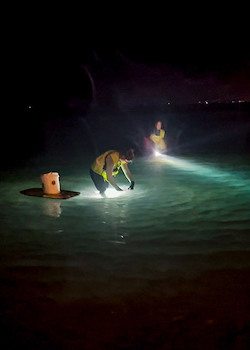
Venomous stings and bites from aquatic species pose a significant but under-researched public health risk, according to a study from the University of Hawaiʻi at Mānoa. Researchers from the John A. Burns School of Medicine (JABSOM), Thompson School of Social Work & Public Health and the Pacific Biosciences Research Center found that aquatic envenomations (venom injected by a bite or sting) pose significant risks to coastal residents, particularly children, and those working in coastal environments.
Although rare among the general population, these incidents are increasingly common in tropical regions, where some of the world’s most venomous species—including box jellyfish, stingrays and cone snails—can cause severe injuries or even fatalities.
Critical gaps in reporting, research

“Our review shows critical gaps in reporting, especially for specific populations and regions,” said lead author Raechel Kadler, a PhD candidate in Associate Professor Angel Yanagihara’s Pacific Cnidaria Research Laboratory in the Department of Tropical Medicine at JABSOM. “For instance, box jellyfish envenomations are well-known throughout the Philippines and responsible for numerous deaths, yet these incidents are rarely covered in the news or included in formal reports.”
Yanagihara, who has led more than 12 field expeditions to the Philippines, emphasized the need for better documentation of the public health impacts of these lethal encounters.
The study also found that high-risk groups, such as coastal workers, children and residents of marginalized areas, are often excluded from available data. These groups face heightened risks due to limited access to medical care.
“Injury is globally underreported, especially in rural areas and among Indigenous Peoples,” said Catherine Pirkle, a professor in the Office of Public Health Studies who supervised this review. “It’s no surprise that aquatic envenomations, which disproportionately affect these groups, remain poorly understood.”
Focus on vulnerable groups, prevention
The researchers are urging more comprehensive studies to assess the full public health burden of aquatic envenomations, particularly in underserved regions and industries. By improving prevention strategies, raising awareness and enhancing medical responses, they hope to better protect those most at risk.
“Our goal is to direct attention and resources to vulnerable populations,” Kadler added. “This work is a step toward improving outcomes for those most affected by these injuries.”

